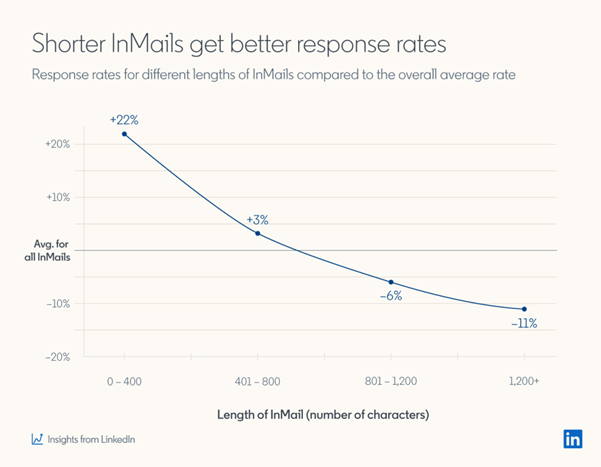LinkedIn’s data shows that InMails receive up to a 4x better response rate than cold emails, yet the point is that they aren’t supposed to be cold.
Only after this groundwork is laid, should you send an InMail.
If you’re already aiming high, then read on for our five best practice tips for InMail success – from increasing your InMail chances before you begin typing to the formula for crafting a compelling InMail that gets results.
1. Warm up your prospects (do this first!)
Highly personalised, relevant and timely InMails can boost your success by around 15% (LinkedIn), but you can increase your chances much further by laying the seeds for a relationship before you contact prospects.
You can warm up your prospects by liking/commenting on their posts. Focus on the relationship building rather than selling. What are their pain points and key challenges? What are the key outcomes they are looking for?
Your goal is to establish credibility and build trust, so ensure that you’ve added some thoughtful insights before reaching out. And space your interactions out – a flurry of likes on their posts before an InMail will be seen for the disingenuous sales approach it is!
Tip: focus on relationship building over selling for better results.
2. Select recipients carefully
The right message to the right person has the best chance of success, so make the most of keywords and filters to find the right person i.e. job title, industry, company, and even skillsets.
You’re also more likely to see success when messaging active LinkedIn users. InMails sent to recipients with a high number of connections and recent activity see a 27% increase in response rates. So before using your LinkedIn InMail credits, check whether they:
- Have a high number of connections
- Are members of relevant LinkedIn groups
- Post frequent, high-value updates
- Have a complete profile
Tip: Lay the groundwork first, comment on their posts, share your insights, and ensure your profile is up to date.
3. Look for common ground or an ice-breaker
Your InMails should make it clear that you’ve taken the time to get to know your recipient. You can easily research their interests and shared connections to find an ice-breaker/insight/common ground by looking at the following:
Their recent activity. Which topics have they posted about or commented on? What are their views? Have they shared any company news?
Who do they follow?
What shared groups or hashtags or people do they follow?
Where did they go to school?
Who are they connected with? Do you have any shared connections?
Do they have similar skills and experience?
Tip: Comment on a shared interest. This makes it clear that you’re reaching out with context, not out of the blue.

4. Check your timing
Timing is everything with prospect emails and it’s the same for LinkedIn. When researching your contact, consider if it’s an appropriate time to contact them by identifying relevant social triggers.
You should regularly check your home feed, email alerts and search results – if you are using Sales Navigator, focus on the spotlight bar – for the following:
- Recent job change
- Promotion
- Recent personal/company mention in the news
- Liked/commented on your article/publication/post
- Recently connected to one of your connections
- Viewed your profile
- Shared an interesting post
- Published an article
- Followed your company on LinkedIn
You also may want to consider when you send your InMails too. Most InMail responses arrive pretty quickly: 50% arrive within the first 24hrs and 80% arrive within one week.
As you can see from the graphic below, Monday to Thursday are the best days to send InMails.
The worst day to send an InMail is on Saturday, which sees 13% fewer responses than average.
 Source: LinkedIn
Source: LinkedIn
5. Learn the components of a highly effective InMail
An eye-catching subject line
64% of sales email recipients will decide whether or not they want to open an email based on the subject line alone (HubSpot).
The best InMail subject lines grab people’s attention by including a business topic that is relevant to the recipient and/or uses a personal touch. While you have 200 characters to use, 25 to 40 characters generally perform best.
According to LinkedIn, the best-performing subject lines contain the following words:
- Thanks
- Connect
- Job opportunities
- Exclusive invitation
- Join us
However, you should always test your subject lines to see what works best for your audience. Once you’ve built up an idea of what works in your area, keep a swipe file of tried-and-tested formulas for the future. Here are some ideas:
- Exclusive invitation to learn from [influencer/leading company in their field]
- Thanks for sharing your post on [business topic]
- How [leading company] drove 25% growth
- Lessons from [leading company in their field] on developing AI
The Ideal InMail Structure
Your InMail should capture your recipients' attention and convey credibility and what value you can offer quickly, so keep it short and snappy (around 150 words generally works best). The response rate for shorter InMails (under 400 characters) is 22% higher than the average response rate for all InMails.

Your InMail shouldn’t be salesy – it's about building a conversation. So keep it about them, not you, by using “you” and “you’re”, not “we” and “we’re” and mention them throughout the InMail.
Here’s an example InMail structure we find works well:
A brief introduction to who you are.
Keep it limited to your name and company. Remember, that the InMail should be about their needs.
A personalised hook.
Why should they care about reading your InMail? What common connection, interest or group do you share? Ensure you keep it personal to them, such as:
- A common connection. We haven’t spoken before but [name], [title] at [company] suggested I get in contact.
- A common interest. I see you attended the webinar on [topic]. I found it really interesting, particularly the part on XYZ.
Build your credibility
The next stage should build your credibility and trust. If sharing a case study, have you achieved results for a shared connection or competitor? Or if you’re sharing an eBook or webinar link, what experience does the author/contributors have that makes it worth their time?
Pain
Once you’ve built up your credibility, you should explain how you’ve helped solve one of the pains that you have uncovered during their research.
e.g.
We were able to help [connection/competitor’ address the challenge of [pain], achieving [result] in [months].
OR
In this webinar, we’ll share how to overcome [challenge 1] caused by [XYZ].
High-level proposition
As mentioned earlier, your goal is to build a relationship and establish credibility and trust, so always offer value with content that helps the recipients understand how you or the content that you are sending could help them overcome their pain/achieve their desired results. This content could be in a form of a video, webinar, eBook, product demo or even a blog.
Call to action
Make sure your recipient understands what action you’d like them to take next if you want a response, such as:
- "Let’s meet for a coffee [at an event they're attending]"
- "If this interests you, shall we have a 15-minute call next Tuesday to discuss?”
- “Sign up for the webinar today. Spaces are limited to 100.”
Crafting an InMail that gets a response takes practice but after a short time, you’ll soon have a ready bank of “swipe file” templates that work best for different scenarios and buyer personas. And with up to an 8x better response rate than cold emails, it’s an art that every social seller should learn.
At Tribal Impact, we go much further than InMails offering training in the art of social selling. If you’d like to find out more, please get in touch.
Editor's Note: This blog was originally published in 2020 and has been refreshed for 2025.

